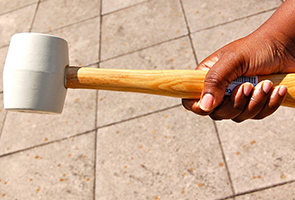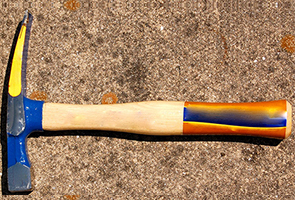If there are two handle grip sizes available and your grip is in-between, consider replacing the handle or modifying it to fit.
Modify the grip -
- If the handle is too large for your hand, you might be able to sand down a wood handle to a smaller grip size. But be careful, reducing the size of the handle could affect the strength of the hammer and may increase the chance of the handle breaking.
- If the handle grip size is too small for your hand, you can apply a tool sleeve or use a padding kit, such as the IMPACTO® Tool Wrap ORTHEX Grip Kit* or ViscolasOrthex™ Grip Kit.* In addition to increasing the handles grip size, these types of products may also provide a steadier grip and reduce vibration and exposure to cold. Wearing gloves may also help since they typically reduce your effective grip size. Anti-vibration gloves also reduce vibration. Depending on the materials and products you are working with a specific type of glove may be recommended or required to protect your hands from skin disorders, such as burns and dermatitis, or other injuries. Note: some workers have reported a reduced sense of touch and needing a stronger grip when wearing gloves. Using a hand tool with a non-slip grip area or adding an anti-slip material may help.
Using a handle made out of a material that produces less vibration along with anti-vibration features, such as a cushion grip, can reduce the risk of vibration-related injuries. Some tools come equipped with anti-vibration handles, such as the Stanley 20 oz. FatMax® AntiVibe® Brick Hammer*.
If you already have a hand/arm injury, a condition such as tendonitis, arthritis, or carpal tunnel syndrome, or a back injury, it is best to select the lightest weight hammer or mallet for the job and take steps to reduce vibration. Using a lighter weight hammer, for example, will reduce the force on the hand and arm, reduce the back strain caused by swinging the hammer, and also be lighter to carry to and from the job site. Remember: lighter weight handles such as fiberglass can reduce the weight of the hammer without reducing the work done by the head.
Example:
Worker Hand Measurements = hand size (length from wrist crease to tip of middle finger) of about 7-1/4" (or 7.25"), with a grip diameter of about 1-2/5" (or 1.4"), a grip size of about 4-3/5" (or 4.6"), and a palm size of 3".
Choices:
16 oz hammer with a tapered wood handle, about 4-1/2" (or 4.5") grip at its widest point and 2-5/8" at the narrowest point, a 9-3/4" handle length, and a total weight of roughly 1 lb 6.4 oz (22.4 oz).
Or
24 oz hammer with a tapered wood handle, about 4-1/2" (or 4.5") grip at its widest point and 3" at the narrowest point, a 9-3/4" handle length, and a total weight of just under 2 lbs (31.8 oz).
What the worker in this example should consider:
- The 24 oz hammer weighs 50% more and will add to the worker's fatigue and risk of injury. In this example, the worker should use the 16 oz hammer if it will do the job.
- For both hammers, the worker should take steps to minimize vibration and ensure a stable grip by using anti-vibration gloves or an anti-vibration wrap. Since both hammers have a grip size slightly smaller than the worker's grip size, use of anti-vibration gloves and/or anti-vibration tape may make the handle grip size closer to the 'best' grip size for this worker.



